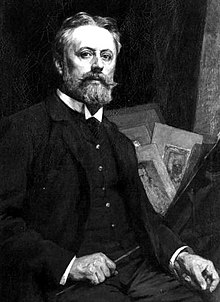Alfred Cluysenaar
Alfred Cluysenaar , (full: Jean André Alfred Cluysenaar ; born September 24, 1837 in Brussels , † November 23, 1902 in Saint-Gilles / Sint-Gillis ) was a Belgian painter , draftsman and watercolorist . His subjects were portrait and history painting .
Live and act
Descended from the Dutch-Belgian branch of the originally Austrian and later in Burtscheid active family of architects Klausener Alfred Cluysenaar is the son of Jean-Pierre Cluysenaar . He is the father of André Cluysenaar and the grandfather of John Cluysenaar .
From 1855 to 1857 Alfred graduated from the Académie Royale des Beaux Arts in Brussels. He was a student of Jean Joseph Jaquet , who taught him sculpture . The David student and director François-Joseph Navez introduced him to painting. His studies from 1857 at the École nationale supérieure des beaux-arts de Paris (ENSA) in Paris and with Léon Cogniet was probably mediated by the painter and graphic artist Louis Gallait .
In collaboration with his father, Alfred Cluysenaar designed the ceiling painting in the town hall of Saint-Gilles with the allegory of truth, goodness and beauty. In the 1860s he supported his father on a commission in Germany , where they designed the theater in Bad Homburg vor der Höhe together . This was followed by stays in Holland and Italy . In 1873 he married Marie-Thérèse Cornélis, who bore him three children.
Cluysenaar created numerous portraits of the royal family, nobles, financiers and politicians. From 1866 he taught in the atelier built by his father in Rue de la Source and at the Institute supérieur des Beaux Arts in Antwerp . In 1891 he became Professor d'Art décoratif et monumental in the successor of Louis Jan De Taeye (1822– 1890) in Antwerp. Alfred Cluysenaar founded and directed the Académie Dessin in Saint Gilles . A street in Saint-Gilles has been named after him since 1907.
His most famous students include Jacques de Lalaing and Jean Delvin . His obituary appeared in the New York Times on November 25, 1902 . In this article, the prominent Belgian artist was referred to as a landscape and portrait painter with a penchant for mythological subjects.
style
Alfred Cluysenaar preferred to perform academically romantic compositions monumentally. His presentation is informal and sensitive. Derrey-Capon compares him to Edouard Agneessens and Lievin de Winne . Cluysenaar's works show the academic influence. His style of painting is cool and formal. In the Gazette des beaux-arts in 1867 Paul Mantz pointed out the affinity of his cardboard boxes to the works of Peter von Cornelius . His subjects included landscapes , which he understood in a cheerful manner, depictions of animals, oriental scenes and nudes.
Awards and memberships
- Officier de l'Ordre de Léopold
- Knight of the Legion of Honor
- Cercle artist. et literature de Bruxelles
- Member of the Académie Royale de Belgique
- 1893 Société des Beaux-Arts de Brussels
- Commandant royale des Mon.
- Commandant you MAD
Works
- 1859 Une femme nue
- 1863 Moine endormi , Brussels
- 1866 The Horsemen of the Apocalypse . He presented this work in 1867 at the Salon de Paris.
- 1868 portrait by M. Degroot
- 1870 Panorama de la bataille de Worth , lithograph for the cover of the plan of the zoological garden in Antwerp.
- 1872 Mazeppa , Koninkl. MSK, Antwerp
- 1872 Deux Enfants , Royal MSK, Antwerp
- 1873 sweet moments
- 1878 portrait of his son André
- 1878 Heinrich IV. In Canossa
- 1873–1879 frescoes for the University of Ghent in collaboration with Lodewijk Jan De Taeye and Victor Lagye
- 1875 André Cluysenaar portrait titled Une Vocation
- 1868 Guillaume de Groot , portrait of the sculptor
- 1870 Emile Sacré , portrait of the painter
- 1882 self-portrait , Uffizi Gallery, Florence
- 1888 Après le bain
- Portrait de Flora Reyntiens
- Around 1890 designs for the decoration of the stairwell in the town hall of Saint-Gilles, executed by his son André Cluysenaar and Jacques de Lalaing
- Paysage vallonné , Musée Communal des Beauy arts, Charleroi
- Les Menestrels ,
- Cardinal la Balue in the cage in front of Louis XI.
literature
- Fanny Cluysenaar: Les Cluysenaar, une famille d'artistes . Weissenbruch, Brussels 1928.
Web links
| personal data | |
|---|---|
| SURNAME | Cluysenaar, Alfred |
| ALTERNATIVE NAMES | Cluysenaar, Jean André Alfred |
| BRIEF DESCRIPTION | Belgian artist |
| DATE OF BIRTH | September 24, 1837 |
| PLACE OF BIRTH | Brussels |
| DATE OF DEATH | November 23, 1902 |
| Place of death | Saint Gilles / Brussels |

